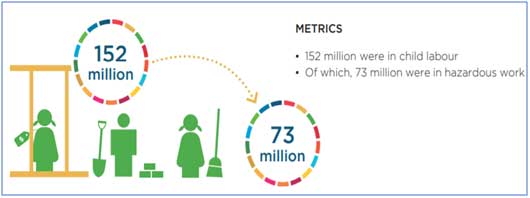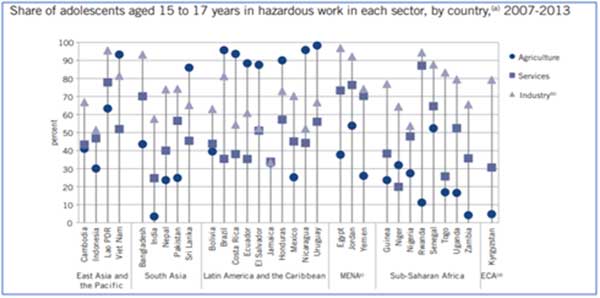Prem Auti
“There can be no keener revelation of a society’s soul than the way in which it treats its children.”
-Nelson Mandela
On 12th June 2019, ILO celebrated 100 years of promoting help and social justice to labor and their family. On this day, ILO defined one of their sustainable development goals as global commitment to eradicate child labor aligning with the United Nation Organization vision of declaring 2021 as the year where world will witness elimination of child labor.
Not only in India, globally, it has been observed that children have always been a topic of limited discussion. Children are considered as the backbone of any society, and the progress of any society is dependent on how society takes care of both physical and mental growth of children. But under certain circumstances, it becomes inevitable and children have to suffer through a lot of physical and mental trauma. This situation usually arrives when parents or the caretaker of children are not in a position to financially support their basic needs. In such cases a child sacrifices his childhood for the mere survival. Most of the child labor representation globally comes from the economically weaker section of the society.
Before we dive into the subject of child labor, it is important to understand the what exactly child labor means. There are many formal definitions of child labor. ILO defines child labor as a work which deprives children from their dignity, primary necessities and forces them to work in hazardous condition which is extremely dangerous for their health. Few organizations, including UNICEF puts the age criteria to child labor. Any child who is between the age of 5 and 11, and who puts 28 hours of economic activity including the domestic work in a week will be considered as child labor. Just to understand the gravity of the situation, in 2017 if we take any calendar day, we will find around 152 million children involved in child labor.

- Source: ILO Report on child labor 2017
Global Characteristics of Child labor
Below are some disturbing facts related to child workers globally:
- The agriculture sector has witnessed the maximum number of child workers. Around 71% of the total child workers are involved in the livestock herding and commercial farming.
- Around 30% of child labor is in family-owned small business. These children are forced by their parents to work in their family business. Addressing this issue is a significant challenge for both the ILO and the state.
- Forced labor is the most dangerous form of child labor. Special attention needs to be paid by the agencies to curb this inhuman form of employment. Around 3 to 4 million of child labor around the globe are working as child labor. They not only have to work in the most hazardous condition but also have to suffer from lack of freedom and menacing of penalty in the workplace.
- The common notion of associating child labor with the economically weaker country is not at all true. Roughly around 56% of the entire child labor comes from developing and underdeveloped countries. Rest 44% is concentrated in the developed countries.
Dual Challenge
The problem is not restricted to the eradication of child labor. A parallelly running problem is the employment of youth along with ensuring a decent workplace for them. The dual challenge is making the world free from child labor and at the same time ensuring the availability of jobs to youths.
To deal with this dual challenge, there is an urgent need of coherent policy which circumscribes the critical issue of child labor, education, and employment opportunities for the youth. It is vital that child enter adolescence with certain kind of essential skills and knowledge so that he or she inculcates threshold competencies required for the any job. These policies will also help in the smooth shifting from the educational institute to the workplace. The policy should also ensure that the philosophy of decent work is not violated by any means. End result of creating decent work place for these youth will eventually have a positive effect on the parents who will start discovering the incentives of investing in their child’s education.

- Coherent policy response to decent youth work and child labor
Following steps are crucial in dealing with this dual challenge:
- Transferring a child into school from labor: As mentioned earlier this step is crucial from the point of view that certain basic knowledge is must when a child enters into the adolescence. The other advantage of intervening early in the life is obliviating the possibility of high cost in the latter stage.
- Smooth Transition from school to work place: State should ensure that there are enough job opportunities available in the market to ensure every student shifting from school to work place gets a job according to his or her skillset. There is no one fit for all strategy to deal with this however it depends on many geo-political factors.
- Eliminating child labor in the age group of 15-17: Around 25% of the total child workers in the world are in the age group of 15-17. Nearly half of them works in a extremely dangerous work environment. Primary task will be on devising a well though risk mitigation plan for these workers and second chance of working in decent workplace.

3 Source: ILO Annual report on child labor 2017
- Paying attention to female children: There are very few opportunities for the female workers in the labor market as well as they face great difficulties in shifting to decent work. It is the responsibility of state to ensure equal opportunities to both male and female. Apart from these macro issues there are several micro issues which need to be addressed like sexual assault at work place, threat of penalty, rape etc.
- Bridging the Knowledge gap related to Child labor and Youth employment:
Various gaps identified are following:
- Impact of child labor in the future outcomes of the labor market
- Understanding and identifying the key factors in a hazardous work environment from the scope of improvement.
- Awareness about the return on education for child labors.
- Genuine efforts towards creating an enabler environment: State framework for combating child labor should be aligned with the international standards set by ILO or UN to ensure effective implementation of policy, awareness programs, etc.
- Awareness among consumers: NGOs and other non-profit organization can play a crucial role in making today’s consumer aware about the malpractices which have been used during the manufacturing. Boycott from consumer can in a way will help to curb child labor.
Accelerated Action Plan to achieve Mission 2021:
There are more than 152 million child workers still suffering from the wrath of hazardous work environment. Following are the primary levers which will accelerate our journey towards a world without child labor.
- Identifying the root causes for the Child Labor: Here are several reasons for the child labor. Social inequality, income disparity, social exclusion, denying the basic rights at work place, poverty is few of the major reason for child labor. Key stakeholders which can play crucial role in this process are legal authority for framing framework, agencies working towards social protection and labor market itself.
- Adoption, Application and Enforcement: It is of prime importance for federal government to formulate a right strategy for the strict enforcement of the labor laws. They should also try to cover the areas which has not been covered under the current framework.
- Key Strategy- Right to education: Education will play a major role in eradicating the child labor. Efforts should me made in the direction of spreading the awareness about the importance of schooling in shaping the future trajectory of career. State should not only also ensure equal opportunity for both girls and boys but also strict enforcement of minimum age of employment.
- Social Protection: Government should ensure that families are not forcing children to meet their basic need under any kind of economic shock. Thus, social protection is very important in order to tackle child labor.
A decent and sustainable income for everyone can be achieved in the near future by eliminating child labor. 1919 was the year when ILO took it as a challenge but since then the mission is yet to be accomplished. Abolition of child labor requires a careful and an urgent attention from different section of society to ensure the success of mission 2021 –”World without child labor”
But for that: “WE MUST ACT NOW”
No comments:
Post a Comment